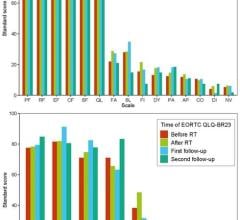
In part to address the 12,000 new cancer cases annually in Saudi Arabia – many of them diagnosed at an advanced stage – King Abdulaziz University Hospital is the first center nationally to acquire image guided treatment technology from Elekta. The 700-bed hospital launched a new era of advanced radiotherapy with the first clinical treatments on its Elekta Synergy system in February 2012, offering patients with difficult cases sophisticated Image Guided Radiation therapy (IGRT) and Volumetric Modulated Arc Therapy (VMAT) for added precision and speed. The hospital also acquired Elekta treatment planning systems in May 2012.
"Managing the planning and treatment of late stage cancers is challenging," says Prof. Yasir Bahadur, M.D., Chairman of the Department of Radiology, under which the Department of Radiation Oncology operates. "We needed user-friendly technology that would allow us to accurately cover the target and protect normal tissues, while treating our patients in a comfortable and timelya manner. We determined that Elekta Synergy met these needs from a technological standpoint."
The hospital had been operating two Siemens linear accelerators and added Elekta Synergy because of its advanced technology, such as kilovoltage [kV] cone beam CT [CBCT] and VMAT.
"While our whole radiotherapy practice has been image guided, the kV 3D volumetric imaging of Elekta Synergy enables us to accurately deliver complex treatment plans. The excellent quality of the kV treatment verification images – versus the megavoltage [MV] images the other linacs produce – allows a clear visualization of soft tissue structures without the need for implanted surrogate markers."
With Elekta Synergy, King Abdulaziz University Hospital has, for the first time, used VMAT in select cases, resulting in dramatic decreases in beam delivery time compared to conventional techniques.
"The beam delivery time for VMAT is about five minutes, compared to nine minutes for dynamic Intensity Modulated Radiation Therapy [IMRT] and 20 minutes for step-and-shoot IMRT," Prof. Bahadur notes. "In addition, we have found that delivery of IMRT is faster on Synergy versus our other systems.
"With Synergy," he continues, "we can easily treat 20 patients daily using either VMAT or dynamic IMRT, with daily CBCT, during eight working hours, which we were unable to do before. Now we can treat more patients and this has shortened our waiting list."
In addition to Synergy, King Abdulaziz University Hospital also acquired Elekta's XiO® and Monaco treatment planning systems, and began using them clinically in May 2012.
"We like the accuracy of the dose calculation algorithms and high speed calculation of both treatment planning systems," Prof. Bahadur observes. "In Monaco, we appreciate the biological modeling feature and the Sensitivity Analysis tool that guide the planner through the plan optimization process."
As the hospital anticipates launching its new stereotactic radiation therapy (SRT) service in February 2013, Prof. Bahadur looks forward to the same level of Elekta support his team received in implementing advanced radiotherapy with Elekta Synergy.
"We have been impressed by the outstanding standard of training activities provided by Elekta to our staff," he remarks. "The professionalism of the application specialists, in addition to their kindness and continuous support are highly appreciated by the entire team. After nearly one year of using Elekta Synergy in our department, we are confident and satisfied with the system, and are very optimistic that with the launch of the SRT service, we will have another opportunity to strengthen our collaboration and partnership."
In July 2010, King Abdulaziz University Hospital introduced Elekta's MOSAIQ Oncology Information System as an upgrade of its LANTIS record & verify system, and recently upgraded MOSAIQ to version 2.4.
"We find MOSAIQ very user-friendly and it integrated seamlessly with our Siemens linacs," Prof. Bahadur says.
For more information: www.elekta.com


 March 28, 2024
March 28, 2024 








